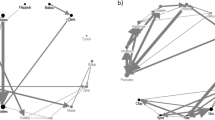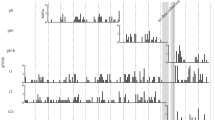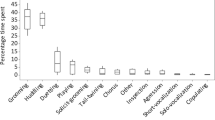Abstract
We studied temporal variation in affiliative behavior among adults in 2 multimale groups of wild Taiwanese macaques from 2 different populations: one in Southern Taiwan, and one in Northern Taiwan. Although the study areas differed dramatically in their elevation, average temperatures, and rainfall patterns, both populations displayed marked similarities. Analyses of grooming and proximity showed that only male-female affiliative patterns had significant temporal variation. The males and females of both populations had the highest frequencies of grooming and proximity in a mating context. Outside of the mating season, male-female affiliation rates dropped dramatically. In contrast, female-female and male-male affiliation patterns showed no significant temporal variation.
Similar content being viewed by others
References
Altmann, J. (1974). Observational study of behavior: Sampling methods. Behaviour 49: 227–265.
Andelman, S. J. (1986). Ecological and social determinants of cercopithecine mating patterns. In Rubenstein, D. I., and Wrangham, R. W. (eds.), Ecological Aspects of Social Evolution, Princeton University Press, Princeton, NJ, pp. 201–216.
Birky, W. A. (2002). Mating Patterns and Social Structure in a Wild Group of Formosan Macaques (Macaca cyclopis). Ph.D. Dissertation, Rutgers University.
Chapais, B. (1983). Structure of the birth season relationship among adult male and female Rhesus monkeys. In Hinde, R. (ed.), Primate Social Relationships: An Integrated Approach, Blackwell, Oxford, pp. 200–208.
Cooper, M. A., and Bernstein, I. (2000). Social grooming in Assamese Macaques (Macaca assamensis). Am. J. Primatol. 50: 77–83.
Cowlishaw, G., and Dunbar, R. I. M. (1991). Dominance rank and mating success in male primates. Anim. Behav. 41: 1045–1056.
Di Fiore, A. (2003). Ranging behavior and foraging ecology of lowland woolly monkeys (Lagothrix lagotricha poeppigii) in Yasuni National Park, Ecuador. Am. J. Primatol. 59: 47–66.
Dunbar, R. I. M. (1988). Primate Social Systems, Cornell University Press, Ithaca, NY.
Ehart, C. (1991). Birth season contingencies and the affiliative behavior of adult male Japanese macaques. In Fedigan, L. M., and Asquith, P. J. (eds.), The Monkeys of Arashiyama: Thirty-Five Years of Research in Japan and the West, SUNY Press, New York, pp. 227–248.
Emlen, S. T., and Oring, L. W. (1977). Ecology, sexual selection, and the evolution of mating systems. Science 197: 215–223.
Fooden, J. (1971). Report on primates collected in western Thailand January–April, 1967. Fieldiana Zool. 59: 1–62.
Fooden, J. (1979.) Taxonomy and evolution of the sinica group of macaques: I. Species and subspecies accounts of Macaca sinica. Primates 10: 109–140.
Fooden, J. (1980). Classification and distribution of living macaques. In Lindburg, D. G. (ed.), The Macaques; Studies in Ecology, Behavior and Evolution, Van Nostrand Reinhold, New York, pp. 1–9.
Fooden, J., and Wu, H. Y. (2001). Systematic review of the Taiwanese macaque, Macaca cyclopis Swinhoe, 1863. Fieldiana (Zoology, New Series) 98: 1–70.
Furuichi, T. (1989). Social interactions and the life history of female Pan paniscus in Wamba, Zaire. Int. J. Primatol. 10: 173–197.
Glick, B. (1980). Ontogenetic and psychobiological aspects of mating activities of male Macaca radiata. In Lindburg, D. L. (ed.), The Macaques: Studies in Ecology, Behavior, and Evolution, Van Nostrand Reinhold, New York, pp. 345–369.
Grewal, B. S. (1980). Social relationships between adult central males and kinship groups at Arashiyama with some aspects of troop organization. Primates 21: 161–180.
Hill, D. A. (1990). Social relationships between male and female Rhesus macaques: II Non-sexual affiliative behavior. Primates 31: 33–50.
Hill, D. A. (1994). Affiliative behaviour between adult males of the genus Macaca. Behaviour 130: 293–308.
Hsu, M. J., and Agoramoorthy, G. (1999). Population dynamics and male leader tenure among Formosan macaques at Mt. Longevity, Taiwan. Am. J. Primatol. 49: 63–64.
Hsu, M. J., Agoramoorthy, G., and Lin, J. F. (2001). Birth seasonality and inter-birth intervals in free-ranging Taiwanese macaques, Macaca cyclopis, at Mt. Longevity, Taiwan. Primates 42: 15–25.
Hsu, M. J., and Lin, J. F. (2001). Troop size and structure in free-ranging Formosan macaques (Macaca cyclopis) at Mt. Longevity, Taiwan. Zool. Stud. 40: 49–60.
Im, R. A. (1990). The ecology and evolution of reproductive synchrony. Trends Ecol. Evol. 5: 135–140.
Kavanagh, M., and Larson, E. (1984). Breeding seasonality among long-tailed macaques, Macaca fascicularis, in peninsular Malaysia. Int. J. Primatol. 5: 17–29.
Manson, J. H. (1991). Female Mate Choice in Cayo Santiago Rhesus Macaques, Unpublished Ph.D. thesis, University of Michigan.
Manson, J. H. (1992). Measuring female mate choice in Cayo Santiago rhesus macaques. Anim. Behav. 44: 405–416.
Manson, J. H. (1994). Female mate choice in primates. Evol. Anthropol. 3: 192–195.
Nunn, C. L. (2000). Collective benefits, free-riders, and male extra-group conflict. In Kappeler, P. M. (ed.), Primate Males: Causes and Consequences of Variation in Group Composition, Cambridge University Press, Cambridge, UK, pp. 192–204.
Ridley, M. (1986). The number of males in a primate group. Anim. Behav. 34: 1848–1858.
Roonwal, M. L., and Mohnot, S. M. (1977). Primates of South Asia, Harvard University Press, Cambridge, MA, xviii + 421 pp.
Smuts, B. B. (1985). Sex and Friendship in Baboons. Aldine de Gruyter, New York.
Smuts, B. B., and Smuts, R. W. (1993). Male aggression and sexual coercion of females in nonhuman primates and other mammals: evidence and theoretical implications. Adv. Study Behav. 22: 1–63.
Soltis, J. (1999). Measuring male-female relationships during the mating season in wild Japanese macaques (Macaca fuscata yakui). Primates 40: 453–467.
Su, H. H. (2003). Within-Group Female-Female Feeding Competition and Intra-Matriline Feeding Competition in Taiwanese Macaques (Macaca cyclopis) at Fu-shan Experimental Forest, Taiwan. Ph.D. Dissertation, Rutgers University.
Takahata, Y. (1982). Social relations between adult males and females of Japanese monkeys in the Arashiyama B Troop. Primates 23: 1–23.
van Hooff, J. A. R. A. M. (2000). Relationships among non-human primate males: a deductive framework. In Kappeler, P. M. (ed.), Primate Males: Causes and Consequences of Variation in Group Composition, Cambridge: Cambridge University Press, Cambridge, UK, pp. 183–191.
van Noordwijk, M. A. (1985). Sexual behavior of Sumatran Long-tailed macaques (Macaca fascicularis). Z. Tierpsychol. 70: 277–296.
van Noordwijk, M. A., and van Schaik, C. P. (1988). Male careers in Sumatran long-tailed macaques (Macaca fascicularis). Behaviour 107: 24–43.
van Schaik, C. P. (2000a). Infanticide by male primates: the sexual selection hypothesis revisited. In van Schaik, C. P., and Janson, C. H. (eds.), Infanticide by Males and Its Implications, Cambridge University Press, Cambridge, UK, pp. 27–60.
van Schaik, C. P. (2000b). Social counterstrategies against infanticide by males in primates and other mammals. In Kappeler, P. M. (ed.), Primate Males: Causes and Consequences of Variation in Group Composition, Cambridge University Press, Cambridge, UK, pp. 34–52.
van Schaik, C. P., Pradhan, G. R., and van Noordwijk, M. A. (2004). Mating conflict in primates: Infanticide, sexual harassment and female sexuality. In Kappeler, P. M., and van Schaik, C. P. (eds.), Sexual Selection in Primates: New and Comparative Perspectives. Cambridge University Press, New York, pp. 131–150.
Widdig, A., Streich, W. J., and Tembrock, G. (2000). Coalition formation among male Barbary macaques (Macaca sylvanus). Am. J. Primatol. 50: 37–51.
Wrangham, R. W. (1980). An ecological model of female-bonded primate groups. Behavior 75: 262–300.
Wu, H., and Lin, Y. S. (1992). Life history variables of wild troops of Taiwanese macaques (Macaca cyclopis) in Kenting, Taiwan. Primates 33: 85–97.
Zumpe, D., and Michael, R. P. (1986). Dominance index: A simple measure of relative dominance status in primates. Am. J. Primatol. 10: 291–300.
Author information
Authors and Affiliations
Corresponding author
Rights and permissions
About this article
Cite this article
Birky, W.A., Su, Hh. Temporal Variation in Adult Affiliation Patterns in Wild Taiwanese Macaques (Macaca cyclopis). Int J Primatol 26, 1251–1266 (2005). https://doi.org/10.1007/s10764-005-8852-z
Received:
Revised:
Accepted:
Issue Date:
DOI: https://doi.org/10.1007/s10764-005-8852-z




